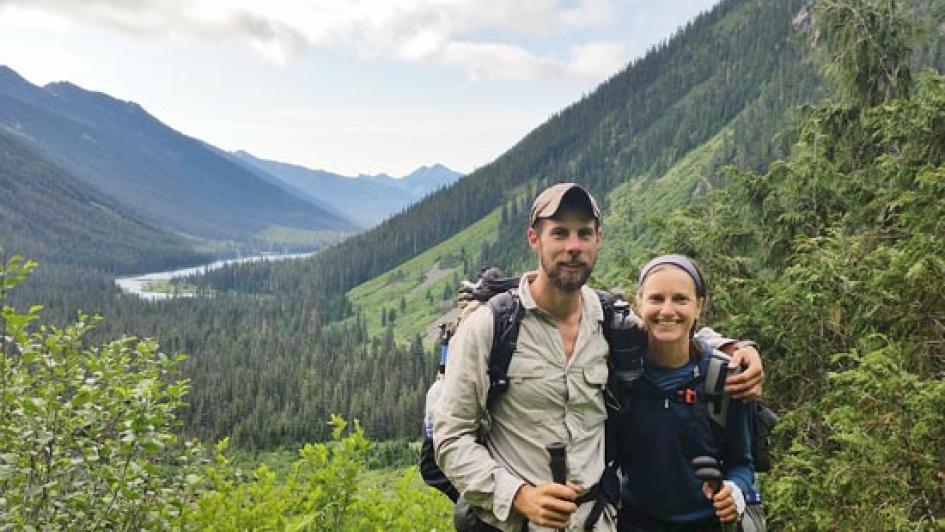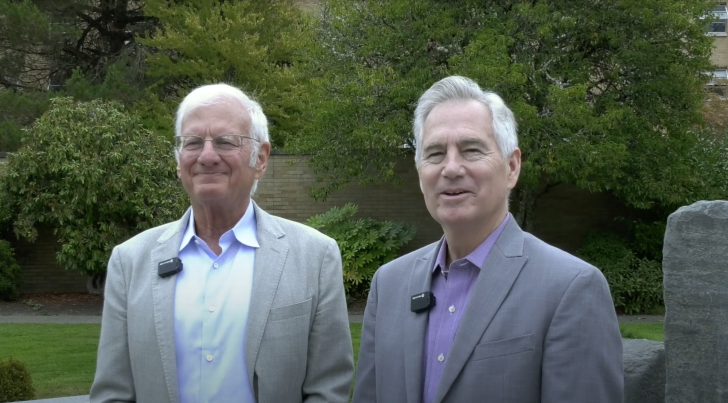Fueling Your Hike with a Plant-Based Diet

Published
In a world full of pre-packaged bars, processed trail food, and preservative-laden snacks, have you ever stopped to wonder about more optimal nutrition for endurance on the hiking trail? And what, exactly, are some of the ideal foods and meals for a sustained hiking trek?
Bastyr University alumni Anna Herby, MS (’14), and her hiking partner Ross Scherer, BS (’13), are avid hikers and huge plant-based diet advocates. Herby earned a Master of Science in Nutrition, while Scherer was busy completing a Bachelor of Science in Nutrition and Exercise Science degree.
Throughout their time at Bastyr, Herby and Scherer — otherwise known as “Bug” and “Mud” on the trail — were always looking to hike whenever and wherever they could. Hiking was not only a shared passion, but also a necessary way of balancing the academic rigors of their coursework with some quality time in nature. In 2014, their collaboration reached new heights (and lengths) when they spent five months hiking 2,600 miles from Canada to Mexico along the Pacific Crest Trail. As Anna says, “There are two things that matter in this world: food and hiking. That's the way I see things anyway.”
After years of experience, Herby and Scherer found that a plant-based diet has taken their hiking stamina and endurance to new levels, and they’ve developed lots of ideas for healthy, satisfying food and meals on the trail. When it comes to preparing for a trek, Anna puts it simply: “We can't walk too far if we don't have the right fuel, and the right fuel happens to be good for both your body and the world.”
These super trekking alumni shared with us some of the nutrition strategies that got them through their many hikes — both short and epic.
(The following is adapted from nourishingjourneypct.com.)
1. Eat carbohydrates. Carbohydrates are the most efficient fuel. Some good sources for the trail include oatmeal, granola, instant rice, beans, mashed potatoes or sweet potatoes, rehydrated hummus, tortillas, rice cakes, couscous and dried fruit. For a shorter hike, you may have the luxury of packing some whole grain bread and fresh apples, oranges, bananas, pears and other fruit!
Eating oatmeal in the morning is one of the easiest ways to start your day with good carbs. In a sealable plastic bag, pack a mixture of quick oats, rolled oats, flax seeds and chia seeds. Place in your pot, add plenty of water and simmer on a camp stove for five minutes. Top it off with a little sweetener, walnuts and cranberries. If you're lucky, you may even find some wild berries to add to your breakfast.
2. Don’t stress about protein. A high-calorie intake naturally leads to a higher protein intake. There is sufficient protein in a balanced, plant-based diet to support the needs of endurance athletes without the need to supplement or shift away from carbohydrates to favor protein. Protein sources on the trail include instant beans, rehydrated hummus, nuts, seeds, energy bars, and vegetables and grains.
The bulk section of a natural market is a great place to find things like instant beans, quick soup mixes and hummus. Carrying small baggies of beans, instant mashed potatoes, soups and various seasonings allows for flexibility. Combine them in different ways to make a delicious medley that goes well wrapped in a tortilla.
3. Eat frequently. A good strategy to maintain energy is eating at least every hour, or at the very first hint of hunger. This prevents energy crashes. Most backpackers keep snacks in the side pocket of their hip belts, making it easy to snack without stopping. Some great snacks include date bars, Clif and Pro bars, dried fruit, pretzels, nuts and seeds.
Try making homemade date bars! Mix one cup of pitted Medjool dates with a half cup of oats and a half cup of nuts (cashews or almonds work best) in a food processor. For variety, try adding flavoring such as chocolate chips, ground coffee, matcha powder, or other dried fruit like apples and cranberries. Spread the mixture on a cookie sheet covered in parchment paper, let harden in the freezer for one hour, and slice into even rectangles. Wrap them in wax paper, seal with tape and they're ready to go!
4. Pack in the fruits and vegetables. Dehydrating home-cooked meals is an ideal way to incorporate a wide variety of vegetables on the trail. Products such as powdered green vegetables are perfect supplements. Dried fruit and dried seaweed are always wonderful options. Lastly, learning to forage for edible greens and berries is a fun and satisfying way to connect with nature and eat fresh produce at the same time. To learn more about foraging, find a local class or check out the book: Edible and Medicinal Plants of the West by Gregory L. Tilford.
To make delicious trail-ready home cooked meals, just cook up your favorite one-pot recipe (Creamy Cashew Polenta and Pasta Primavera work well) and load it up with vegetables. Chop all vegetables as small as possible so they both dehydrate and rehydrate faster. Spread thinly on dehydrator sheets, let it dehydrate for 8-12 hours or until dry and crunchy, then seal it in a plastic bag. (For longer storage, place in an air tight Mylar bag with an oxygen absorber.)
When you're ready to eat it after a long day of hiking, place the meal in your pot and cover with about half an inch water. Bring to a boil, then let sit for 10 minutes.
5. Stay “plant-strong” in towns. It may be hard to find vegetarian options on menus in small mountain towns, but most restaurants are able to serve steamed vegetables with potatoes on request. Alternatively, make a meal of side dishes. Hashed browns with salsa, wrapped up in a tortilla with veggies and a glass of orange juice is an easy option. For a bigger meal, try a bean burrito from a Mexican restaurant, or a cheese-less pizza topped with lots of vegetables from a local pizza joint.
6. Plan ahead. For hikes longer than 100 miles, mailing resupply boxes of food to towns along the way is necessary. Post offices in towns near the longer trails are accustomed to holding packages for hikers to pick up. There are also small stores, lodges, gas stations and even bars that will accept hiker packages.
Want to learn more about hiking, food, and Mud and Bug’s past and upcoming adventures? Check out their blog.
Scherer also has plans to form a plant-based lifestyle club on Bastyr’s campus this fall when he returns to enter the Master in Public Health program. He has ambitious aims to create a plant-based lifestyle movement at Bastyr, and share its many benefits with others. Contact Ross (via the MyBU directory) to be added to the club mailing list.


